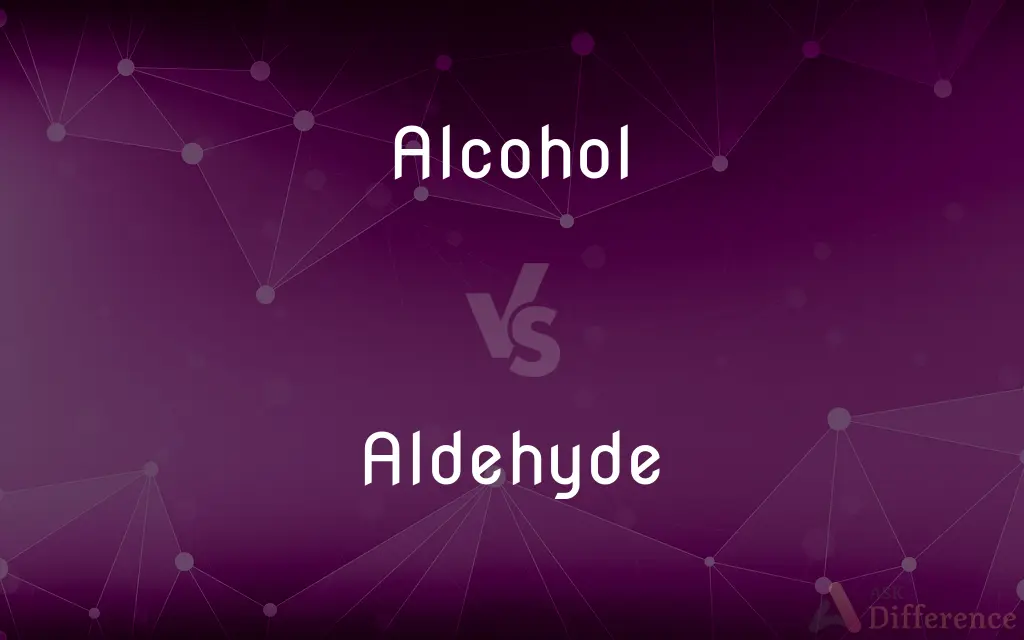Alcohol vs. Aldehyde — What's the Difference?
By Tayyaba Rehman & Fiza Rafique — Updated on March 11, 2024
Alcohol and aldehyde are both organic compounds with significant differences in their functional groups and reactivity.

Difference Between Alcohol and Aldehyde
Table of Contents
ADVERTISEMENT
Key Differences
Alcohol is characterized by its hydroxyl (-OH) group attached to a carbon atom, making it polar and capable of hydrogen bonding, thus influencing its solubility and boiling points. Aldehydes, on the other hand, feature a carbonyl group (C=O) connected to at least one hydrogen atom, rendering them more reactive towards nucleophiles due to the electrophilic nature of the carbonyl carbon.
Alcohols generally have higher boiling points compared to aldehydes of similar molecular weight, due to the ability of alcohols to form hydrogen bonds, while aldehydes cannot. This property makes alcohols more soluble in water than aldehydes.
In terms of reactivity, alcohols can undergo a variety of reactions, including dehydration to form alkenes and oxidation to produce aldehydes or ketones, depending on the alcohol's classification (primary, secondary, or tertiary). Aldehydes are typically more reactive than alcohols in nucleophilic addition reactions due to the partial positive charge on the carbonyl carbon.
Aldehydes can be further oxidized to carboxylic acids, which is a key difference from alcohols, as this showcases the aldehydes' susceptibility to oxidation. This feature is often exploited in various chemical syntheses and industrial processes.
Alcohols serve a wide range of purposes, from being solvents, fuels (like ethanol), and antiseptics, to playing crucial roles in the creation of perfumes, flavorings, and pharmaceuticals. Aldehydes, while also used in industrial and chemical synthesis, are renowned for their application in the fragrance industry, such as formaldehyde in embalming fluids and vanillin in flavorings.
ADVERTISEMENT
Comparison Chart
Functional Group
Hydroxyl (-OH)
Carbonyl (C=O) with at least one H atom attached
Boiling Point
Generally higher due to hydrogen bonding
Generally lower due to lack of hydrogen bonding
Solubility in Water
Generally high due to hydrogen bonding
Lower compared to alcohols
Reactivity
Can undergo oxidation and dehydration
More reactive in nucleophilic addition reactions
Common Uses
Solvents, fuels, antiseptics, pharmaceuticals
Fragrances, chemical synthesis, preservatives
Compare with Definitions
Alcohol
A hydroxyl-containing compound.
Methanol (CH3OH) is used as a solvent and fuel.
Aldehyde
An organic compound with a carbonyl group bonded to a hydrogen.
Formaldehyde (HCHO) is used in embalming.
Alcohol
Can be primary, secondary, or tertiary, based on the -OH group's attachment.
Isopropanol is a secondary alcohol.
Aldehyde
Commonly used in perfumery and flavorings.
Vanillin, an aldehyde, is used for vanilla flavor.
Alcohol
An organic molecule with one or more -OH groups.
Ethanol is found in alcoholic beverages.
Aldehyde
Characterized by the presence of a -CHO group.
Acetaldehyde is produced from ethanol oxidation.
Alcohol
Often used as an antiseptic.
Ethanol in hand sanitizers kills bacteria and viruses.
Aldehyde
Can be oxidized to carboxylic acids.
Acetaldehyde oxidizes to acetic acid.
Alcohol
Can undergo oxidation to form aldehydes or ketones.
Ethanol oxidizes to acetaldehyde.
Aldehyde
More reactive than ketones in nucleophilic additions.
Formaldehyde readily undergoes reactions with nucleophiles.
Alcohol
In chemistry, alcohol is an organic compound that carries at least one hydroxyl functional group (−OH) bound to a saturated carbon atom. The term alcohol originally referred to the primary alcohol ethanol (ethyl alcohol), which is used as a drug and is the main alcohol present in alcoholic drinks.
Aldehyde
Chemically, an aldehyde is a compound containing a functional group with the structure −CHO, consisting of a carbonyl center (a carbon double-bonded to oxygen) with the carbon atom also bonded to hydrogen and to any generic alkyl or side chain R group. The functional group itself (i.e.
Alcohol
Any of a series of hydroxyl compounds, the simplest of which are derived from saturated hydrocarbons, have the general formula CnH2n+1OH, and include ethanol and methanol.
Aldehyde
An organic compound containing the group —CHO, formed by the oxidation of alcohols. Typical aldehydes include methanal (formaldehyde) and ethanal (acetaldehyde).
Alcohol
A colorless volatile flammable liquid, C2H5OH, synthesized or obtained by fermentation of sugars and starches and widely used, either pure or denatured, as a solvent and in drugs, cleaning solutions, explosives, and intoxicating beverages. Also called ethanol, ethyl alcohol, grain alcohol.
Aldehyde
Any of a class of highly reactive organic chemical compounds obtained by oxidation of primary alcohols, characterized by the common group CHO, and used in the manufacture of resins, dyes, and organic acids.
Alcohol
Intoxicating beverages containing ethanol considered as a group
The national consumption of alcohol.
Aldehyde
(organic compound) Any of a large class of reactive organic compounds (R·CHO) having a carbonyl functional group attached to one hydrocarbon radical and a hydrogen atom.
Alcohol
Any of a class of organic compounds (such as ethanol) containing a hydroxyl functional group (-OH).
Aldehyde
A colorless, mobile, and very volatile liquid obtained from alcohol by certain processes of oxidation.
Alcohol
(colloquial) Ethanol.
Aldehyde
Any compound having the group -CHO. Methyl aldehyde, the simplest aldehyde, is more commonly called formaldehyde, H-CHO, and acetic aldehyde is now more commonly called acetaldehyde. The higher aldehydes may be solids. A reducing sugar typically contains the aldehyde group.
Alcohol
(uncountable) Beverages containing ethanol, collectively.
Aldehyde
Any of a class of highly reactive chemical compounds; used in making resins and dyes and organic acids
Alcohol
(obsolete) Any very fine powder.
Alcohol
An impalpable powder.
Alcohol
The fluid essence or pure spirit obtained by distillation.
Alcohol
Pure spirit of wine; pure or highly rectified spirit (called also ethyl alcohol or ethanol, CH3.CH2.OH); the spirituous or intoxicating element of fermented or distilled liquors, or more loosely a liquid containing it in considerable quantity. It is extracted by simple distillation from various vegetable juices and infusions of a saccharine nature, which have undergone vinous fermentation.
Alcohol
A class of compounds analogous to vinic alcohol in constitution. Chemically speaking, they are hydroxides of certain organic radicals; as, the radical ethyl forms common or ethyl alcohol (C2H5.OH); methyl forms methyl alcohol (CH3.OH) or wood spirit; amyl forms amyl alcohol (C5H11.OH) or fusel oil, etc.
Alcohol
A liquor or brew containing alcohol as the active agent;
Alcohol (or drink) ruined him
Alcohol
Any of a series of volatile hydroxyl compounds that are made from hydrocarbons by distillation
Common Curiosities
What defines an alcohol?
An alcohol is defined by the presence of one or more hydroxyl (-OH) groups attached to a carbon atom in its molecule.
Why do alcohols generally have higher boiling points than aldehydes?
Alcohols can form hydrogen bonds, leading to higher boiling points compared to aldehydes, which cannot form hydrogen bonds.
Can aldehydes form hydrogen bonds like alcohols?
Aldehydes cannot form hydrogen bonds like alcohols, leading to lower boiling points.
What is a common use of alcohols in everyday life?
Alcohols are commonly used as antiseptics, in beverages, and as solvents.
What happens when aldehydes are oxidized?
When oxidized, aldehydes typically form carboxylic acids.
How are aldehydes used in the fragrance industry?
Aldehydes are used for their distinctive scents in perfumery and as flavoring agents.
What role do aldehydes play in chemical synthesis?
Aldehydes are key intermediates in many synthesis reactions, particularly in the formation of alcohols, acids, and other derivatives.
Can alcohols be oxidized to aldehydes?
Yes, primary alcohols can be oxidized to form aldehydes.
How do aldehydes differ from alcohols in structure?
Aldehydes contain a carbonyl group (C=O) bonded to at least one hydrogen atom, unlike alcohols which have a hydroxyl (-OH) group.
Are aldehydes soluble in water?
Aldehydes are soluble in water to some extent, but generally less so than alcohols due to the lack of hydrogen bonding.
Can alcohols be dehydrated?
Yes, alcohols can undergo dehydration to form alkenes.
What distinguishes primary, secondary, and tertiary alcohols?
The classification depends on the number of carbons attached to the carbon bearing the hydroxyl group: one for primary, two for secondary, and three for tertiary.
Is it possible for alcohols to form ketones?
Yes, secondary alcohols can be oxidized to form ketones.
How does the reactivity of aldehydes compare to ketones?
Aldehydes are generally more reactive than ketones due to the presence of a hydrogen atom attached to the carbonyl carbon, making them more susceptible to nucleophilic attacks.
Are all alcohols safe for consumption?
Not all alcohols are safe for consumption; only certain alcohols like ethanol are safe in limited quantities, while others like methanol are toxic.
Share Your Discovery

Previous Comparison
Xterm vs. Terminal
Next Comparison
Tramp vs. TrapAuthor Spotlight
Written by
Tayyaba RehmanTayyaba Rehman is a distinguished writer, currently serving as a primary contributor to askdifference.com. As a researcher in semantics and etymology, Tayyaba's passion for the complexity of languages and their distinctions has found a perfect home on the platform. Tayyaba delves into the intricacies of language, distinguishing between commonly confused words and phrases, thereby providing clarity for readers worldwide.
Co-written by
Fiza RafiqueFiza Rafique is a skilled content writer at AskDifference.com, where she meticulously refines and enhances written pieces. Drawing from her vast editorial expertise, Fiza ensures clarity, accuracy, and precision in every article. Passionate about language, she continually seeks to elevate the quality of content for readers worldwide.














































